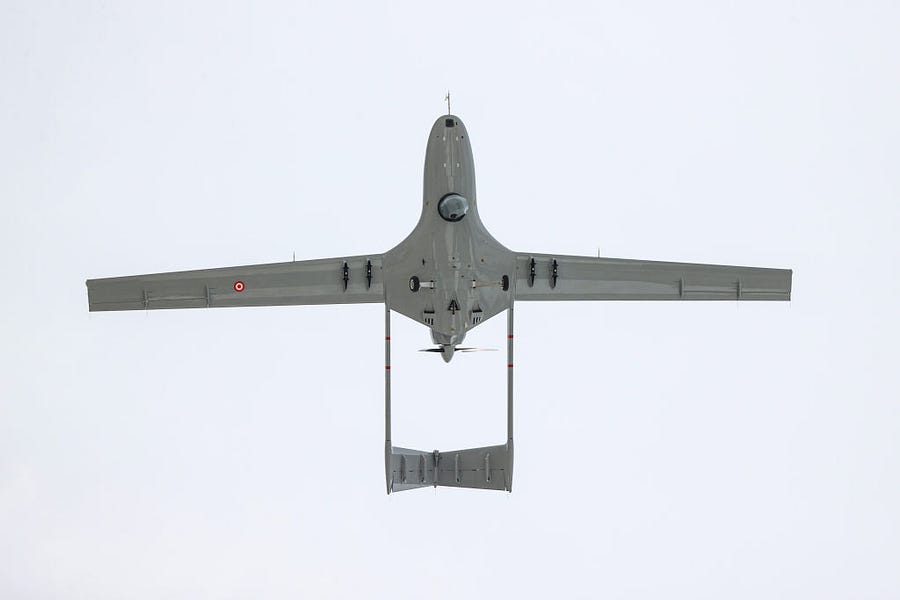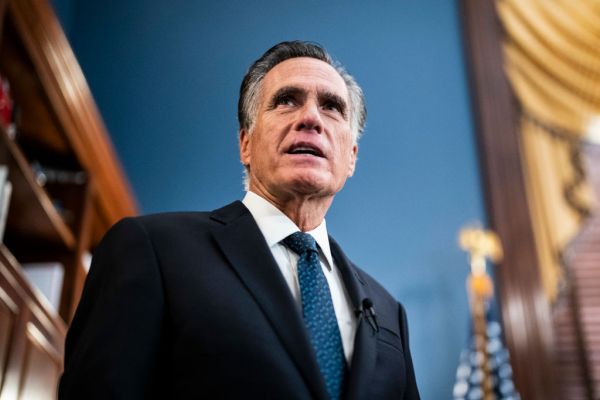In the early hours of July 11, 2014, Ukrainian ground troops camped out near the border town of Zelenopillya began to hear the familiar hum of Russian drones surveilling their position overhead. Shortly thereafter, a barrage of Russian short-range rocket fire hit the brigades, which had in recent weeks gained significant ground against Moscow-backed separatist forces. The sophisticated attacks destroyed several heavy artillery units and killed at least 30 Ukrainian soldiers. Hundreds more were injured.
Russian President Vladimir Putin’s invasion of Ukraine began with a slow trickle of unmarked fighters masquerading as separatists and swelled into an onslaught of tanks, howitzers, and reconnaissance and military aircrafts. The 2014 offensives pitted Moscow’s technological might against Kyiv’s reserves of ground forces in what, for Ukraine, was a war of attrition. The massacre at Zelenopillya confirmed the Kremlin’s strategic edge, establishing for good the efficacy of unmanned aerial vehicles (UAVS) on the frontline.
As American intelligence warns of another push by Moscow across Ukraine’s border early next year, the Russians appear poised to combine air support and surveillance missions with brute force. A new report leaked to Bloomberg lays out a scenario in which Putin mobilizes up to 100 tactical battalions—around 100,000 soldiers—and tens of thousands of reservists in their wake to occupy any new territory. The incursion would be accompanied by the same integrated drone and artillery operations which proved so painful to Kyiv in 2014.
The influx of Russian troops near Ukraine’s border could be another false alarm to keep Ukraine on its toes and/or force concessions from the West. We saw that dynamic at play when Putin mobilized forces and armaments in the spring, landing a summit with Secretary of State Anthony Blinken two months later. But this time around, the movement of troops has been quieter and larger, prompting warnings from experts that it could be the real deal.
Secretary of State Anthony Blinken noted his concern earlier this month, pointing to Putin’s pattern of establishing a false rationale before launching unlawful offensives. “We don’t know what President Putin’s intentions are, but we do know what’s happened in the past,” Blinken told reporters. “We do know the playbook of trying to cite some illusory provocation from Ukraine or any other country and then using that as an excuse to do what Russia is planning to do all along.”
One difference this time around, if Russia is on the hunt for a pretext to re-invade Ukraine, is that the Ukrainians may well be better prepared. In the ongoing war between Russian-backed separatists and Ukrainian soldiers in the country’s east, Kyiv recently responded to deadly howitzer fire with a Turkish-produced Bayraktar TB2 drone. Ukraine’s access to armed, unmanned aircrafts startled Moscow, which has long enjoyed technological superiority over its former satellite state.
“We really have special and good relations with Turkey but this case, unfortunately, confirms our concerns that the deliveries of such armaments to the Ukrainian military may potentially destabilize the situation at the engagement line,” said Kremlin spokesman Dmitry Peskov last month. Spokespeople for France and Germany—NATO allies, like Turkey—also condemned the strike after apparent pressure from Russia.
Whether Moscow’s outward rage is genuine or sensationalized to justify an eventual offensive, it’s clear that Kyiv’s deepening defensive ties with Ankara could pose a strategic threat to Putin’s preferred regional balance. Earlier this month, Ukrainian President Volodymyr Zelensky and Turkish President Recep Tayyip Erdoğan spoke over the phone to reiterate support for an upcoming summit in Kyiv to advance the two countries’ mutual security interests. The Black Sea neighbors have also collaborated on a number of joint defense projects, including plans to co-produce Turkish-developed drones. “[Our] partnership is deepening,” Zelensky tweeted. “It’s already strengthening the armed forces of our countries.”
Although Erdoğan and Putin enjoy close personal relations, much to the chagrin of the West, the two strongmen have found themselves at opposing ends of various conflicts across the globe, including the Nagorno-Karabakh War last year between Armenia and Azerbaijan. These “proxy” wars have granted Russia a front row seat to Turkey’s ascension to the status of a “drone superpower,” as Ankara breaks a Cold War-era monopoly held by the U.S., Soviet Union, and Israel.
During the 44-day Nagorno-Karabakh War—in which Russia backed Armenia and Erdoğan supported Azerbaijan—Turkish-produced UAVs proved decisive in Azerbaijan’s eventual claim to victory. Bayraktar TB2 drones—the same as those used in Ukraine—staked out and eliminated, either through integrated air support or their own ammunition, top-dollar Armenian tanks, vehicles, and air defense systems.
“The defense industry in Turkey is very important to Erdoğan, so they’ve developed this drone technology that has proven itself during the Azerbaijan-Armenia conflict,” Jim Townsend, former U.S. deputy assistant secretary of defense for Europe and NATO, told The Dispatch. “They sold it to Ukraine, even though it was going to be something that would certainly ruffle Russian feathers. So I think it really shows that as far as the Turks are concerned, there aren’t friends, there are interests.”
Many experts attribute Ankara’s expeditious development of indigenous UAV capabilities to strict export controls on drone technology by its earliest inventors. In 1987, several countries agreed to adopt the Missile Technology Control Regime (MTCR), an “informal political understanding,” which, for some time, severely curbed the sales of certain types of drones to countries who had yet to develop them.
This agreement is believed to have catalyzed the technological innovation in Turkey’s domestic defense industry, beyond the watchful eye of the U.S. or American manufacturers. Ukraine’s partial reliance on Ankara for battle-ready UAVs is a good example of the agreement’s shortcomings.
“We have this long tradition, in terms of arms sales, to try to make sure we don’t worsen regional stability by allowing an export to cause an arms race. … In the case of something like drones, we’d rather be the one to sell them than the Turks or someone else who may not have the kind of controls that we have,” said Townsend. “For moral, ethical, strategic stability reasons, we might not approve a drone sale to a certain country, but the Turks would. So the debate becomes: Should we go ahead and do it because if we don’t, the Turks will? At least we can turn off spare parts [exports].”
While the Trump administration relaxed its interpretation of the MTCR to expedite American drone exports to allies last year, Tom Karako—director of the Missile Defense Project at the Center for Strategic and International Studies—argues that further reform may be required.
“The Trump administration loosened MTCR restrictions for UAV sales, a salutary and overdue move that might not have gone far enough,” Karako told The Dispatch. “We’re at a Marie Kondo moment for arms control regimes of all kinds. We have to ask ourselves if they continue to bring us joy. If they do not, we should thank them for their service and send them on their way.”







Please note that we at The Dispatch hold ourselves, our work, and our commenters to a higher standard than other places on the internet. We welcome comments that foster genuine debate or discussion—including comments critical of us or our work—but responses that include ad hominem attacks on fellow Dispatch members or are intended to stoke fear and anger may be moderated.
You are currently using a limited time guest pass and do not have access to commenting. Consider subscribing to join the conversation.
With your membership, you only have the ability to comment on The Morning Dispatch articles. Consider upgrading to join the conversation everywhere.